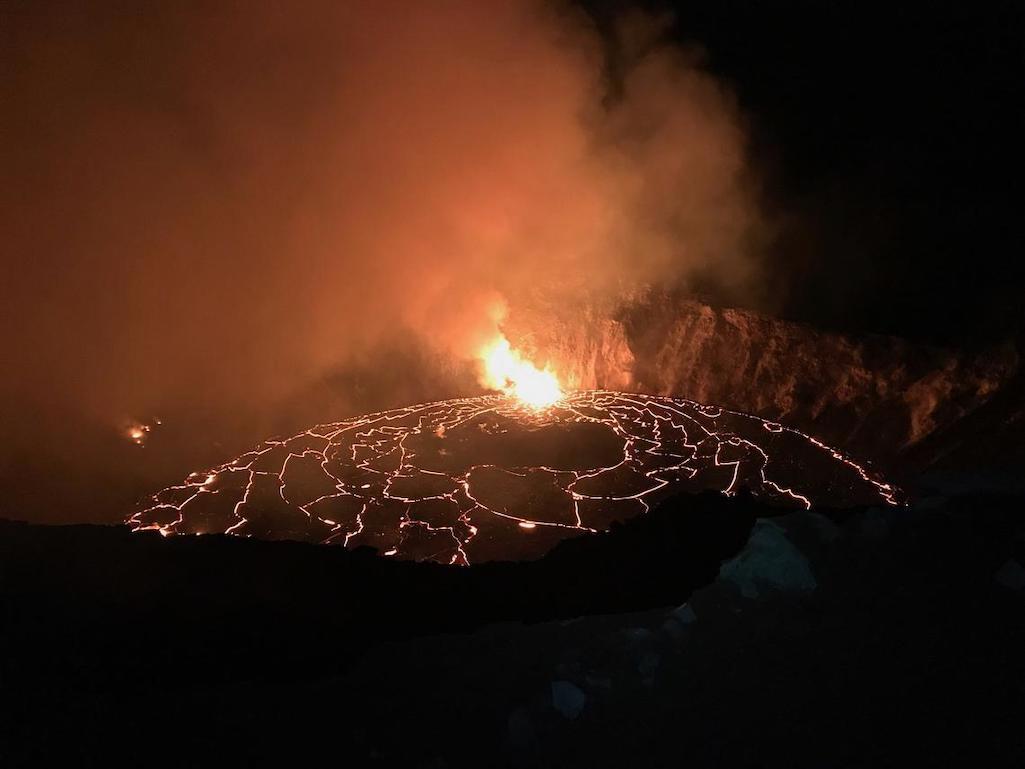
There are safe, and unsafe, areas to watch the Kīlaeua eruption at Hawai'i Volcanoes National Park. This family watches from a safe distance/NPS
Usually when visitors enter a restricted area in a national park they risk being cited by a ranger, but at Hawai'i Volcanoes National Park these days they could be killed by a volcano.
Staff at the USGS's Hawaiian Volcano Observatory say that the return to life of the Kīlaeua Volcano has brought along dangerous levels of volcanic gases, along with the possibility of deadly explosions and volcanic glass particulates in the air that could damage your lungs.
So far the eruption that started early this week is contained within a closed area at Halemaʻumaʻu, the summit crater, where a rising lava lake is being fed by two vents gushing molten rock. The area has been closed since 2007. Crater edges at Halemaʻumaʻu and along Kīlauea caldera are extremely unstable, and collapses can occur at any time. the observatory staff warns. Visitors should stay back from cliff edges and heed closure notices and barriers.

An early December 25, 2020, morning view of the ongoing eruption in Halema‘uma‘u crater at Kīlauea's summit. Overnight fountaining continued to feed the rising lava lake, which slowly fills Halema‘uma‘u. This photo, taken at approximately 2:30 a.m. from the south rim of the crater, shows the main northern vent that is being drowned by the rising lava lake./ USGS photo by J. Schmith and C. Parcheta.
Despite these potentially lethal hazards, park rangers have cited dozens of careless individuals intent on snapping a photo or video for social media bragging rights, a park release said.
“All it takes is a slight change in wind direction and these offenders could inhale a fatal dose of volcanic gas. One misstep or a crumbling cliff edge and they could plunge into the vast pit of molten rock or to the crater floor,” said Chief Ranger Jack Corrao. “We want to keep the park open so everyone can safely experience this beautiful new eruption, but when visitors enter closed areas, rangers must concentrate on these few individuals. This puts our staff in hazardous situations and causes them to shift their focus away from the safety of visitors experiencing the eruption in designated viewing areas."
Designated viewing areas that are open 24 hours a day include Waldron Ledge, Wahinekapu, Mauna Loa Lookout, Keanakākoʻi crater, and Volcano House. Kīlauea Overlook is best visited before sunrise to avoid crowds. A plume of gas and steam can be seen wafting from the crater during daylight hours. After dark, the lava deep within the crater paints the crater walls and plume with mesmerizing eruptive colors.
Visitors are warned that these open areas also present hazards, especially near unstable cliff edges and during periods of poor air quality. The public is reminded to recreate responsibly and heed these precautions:
Volcanic eruptions can be hazardous and change at any time.
Stay on marked trails and overlooks, and avoid earth cracks and cliff edges. Do not enter closed areas.
Hazardous volcanic gases are billowing out the crater and present a danger to everyone, especially people with heart or respiratory problems, infants, young children and pregnant women. Go to www.hawaiiSO2network.com to monitor conditions.
Slow down and drive safely.
Maintain social distance of six feet from others and wear a mask to reduce the spread of COVID-19. Masks do not protect against volcanic gas.

 Support Essential Coverage of Essential Places
Support Essential Coverage of Essential Places







Add comment